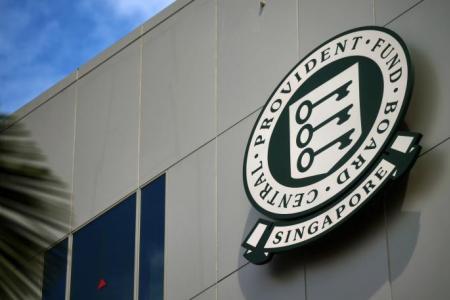How will the changes in CPF Basic Retirement Sum affect me?
The CPF Basic Retirement Sum (BRS) will be raised by 3.5 per cent a year for the next five cohorts turning 55 from 2023 to 2027.
Finance Minister Lawrence Wong said in the Budget speech last Friday (Feb 18) that this is to provide Central Provident Fund (CPF) members higher monthly payouts in their retirement years.
Here are answers to some questions you may have about the BRS.
1. What is the Basic Retirement Sum?
It is the amount you should set aside in your Retirement Account when you turn 55 so that you can receive a monthly sum that the Government believes will cover your basic living expenses in retirement, assuming you do not need to pay rent.
CPF members receive lifelong monthly payouts through the CPF Life scheme after they reach the eligible age - currently 65 for those born from 1954.
Under the scheme, a member's payouts depend on how much is saved in his Retirement Account when he joins CPF Life any time between the ages of 65 and 70. The savings are used as a premium to buy an annuity, which is a financial product that grows one's savings to provide regular payouts.
The BRS for members turning 55 this year is $96,000. This translates into monthly payouts of about $790 to $850 in retirement, if payouts start at 65, under the CPF Life Standard Plan.
There are three types of CPF Life plans – Escalating, Standard and Basic – with different payout structures.
2. What are the Full Retirement Sum and Enhanced Retirement Sum?
The Full Retirement Sum is two times the BRS, while the Enhanced Retirement Sum is three times the BRS.
When a member turns 55, savings from his Special and Ordinary Accounts up to the Full Retirement Sum will be transferred into his newly created Retirement Account.
For CPF members turning 55 this year, setting aside the Full Retirement Sum of $192,000 will result in lifelong payouts of around $1,470 to $1,570 each month if payouts start at 65, under the CPF Life Standard Plan.
This payout level is targeted at people who do not own a property and thus may need to pay rent while retired.
The maximum amount of savings a CPF member can use for the CPF Life scheme is the Enhanced Retirement Sum, plus any accumulated interest in his Retirement Account.
For CPF members turning 55 this year, setting aside the Enhanced Retirement Sum of $288,000 will result in lifelong payouts of around $2,140 to $2,300 each month, if payouts start at 65, under the CPF Life Standard Plan.
3. Why the need to increase the BRS by 3.5 per cent a year from 2023 to 2027?
For each successive cohort of members turning 55, CPF Life payouts need to be higher to account for long-term inflation and a rising standard of living, and the BRS increases correspondingly, said the Manpower Ministry on its website.
The BRS for each cohort is calculated such that the monthly CPF Life payout a member will receive is based on the expected spending needs in 10 years' time for retirees in the lower-middle spending range, according to the latest Household Expenditure Survey. It assumes the member owns a home that can last him until age 95, and does not need to pay rent in retirement.
Using the higher BRS, the payouts for men turning 55 in 2027 on the CPF Life Standard Plan will be close to $1,000 a month when they turn 65. In comparison, men turning 55 in 2022 would get BRS payouts of about $850 a month.
When the concept of the BRS was introduced by the CPF Advisory Panel in 2015, the panel recommended that it be increased by 3 per cent each year for members who turn 55 between 2017 and 2020.
As a gauge, increases in the Minimum Sum, which was the benchmark used before the BRS, ranged from 3.9 per cent to 10.4 per cent between July 2008 and July 2015.
During the Unity Budget statement in 2020, Deputy Prime Minister Heng Swee Keat said that the BRS would be raised by 3 per cent each year for members turning 55 between 2021 and 2022.
4. Am I affected by the 3.5 per cent increase?
Those turning 50 to 54 this year - they turn 55 in 2023 to 2027 - are covered by this round of changes. The Straits Times has asked the CPF Board for the total number of CPF members in each of these cohorts.
5. What happens if I do not meet the BRS when I turn 55?
You do not have to top up your CPF accounts with cash or sell your property. But you will have lower CPF Life payouts as the premium used to buy the annuity will be smaller.
You can withdraw up to $5,000 of your Special and Ordinary Account savings from age 55 even if you do not meet your BRS.
Manpower Minister Tan See Leng said in a Facebook post last Friday after the Budget speech that about eight in 10 active CPF members aged 55 in 2027 are expected to have at least the BRS. He did not say how big this group is projected to be.
If you want to increase your savings, you or your loved ones can top up your Special Account (SA) if you are below 55, or Retirement Account (RA) if you are 55 and above.
The Government will also match every dollar of cash top-ups made to the Retirement Accounts of eligible members, up to $600 a year. This is under the Matched Retirement Savings Scheme launched last year, which will first run for five years.
6. With the BRS going up, are there any changes to how much I can withdraw from my CPF accounts?
Dr Tan said in his Facebook post that there are no changes to CPF withdrawal rules.
This means that besides being able to withdraw up to $5,000 from your Special and Ordinary Account savings from age 55 unconditionally, you can withdraw any further amount from these accounts from age 55 as long as you have the Full Retirement Sum in your Retirement Account. You must draw down your Special Account balance first before drawing from your Ordinary Account.
You can also withdraw savings from your Retirement Account from age 55 as long as you leave your BRS there, if you own a property that can last you up to age 95.
If you are turning 65 from next year onwards, you can withdraw up to 20 per cent of your Retirement Account savings as at age 65, in a lump sum.
Get The New Paper on your phone with the free TNP app. Download from the Apple App Store or Google Play Store now


